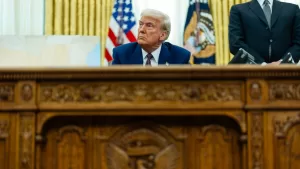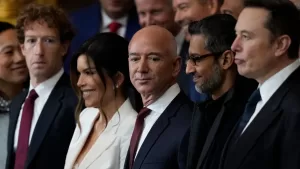Rostam Pourzal
When Naomi Klein brilliantly coined the term “disaster capitalism” for systemic sale of public sector assets, it was seen most applicable to reconstruction after Iraq and New Orleans devastations. Those are stark examples of abusive “market reforms” rushed in to benefit eager outside investors when a coveted society disintegrates. But a similar fate can befall a stable nation, too, if it is sufficiently beleaguered. In Iran this year, a less violent gut punch is unshackling native neoliberal ambitions not seen in four decades. The nation’s unending bid to attract international capital has been stymied by a mix of U.S.-led trade sanctions from the outside and mixed opinion on the home front. Precisely this stunted globalization, now combined with historically low oil revenue, is at long last giving deregulation and privatization their best chance in Iran since revolution and war led to wholesale nationalization of strategic industries in the 1980s. As a result, the Tehran Stock Exchange (TSE) index is skyrocketing when its counterparts around the world have sunk. “Even when measured in hard currency it is the world’s best-performing index”, according to The Economist. A renewed interest in government bonds and public-private partnerships is also gaining ground. The underlying desperation is a historic opportunity for libertarian reform parties (the so-called “pragmatists”) embodied by President Hassan Rouhani to push against social spending and for deregulation.
Creeping divestment and sporadic laissez-faire had previously achieved trivial successes in recent decades, rarely without scandal and resignations over alleged abuse. Policymakers have intermittently encouraged privatization under pressure from the reformist faction to raise productivity and discourage outflow of capital to Dubai and beyond. Still infrastructure contracting, agribusiness, heavy manufacture, utilities, refineries, mining, petrochemicals, hospitals, banking and insurance remain one way or another largely in the government portfolio (including government-affiliated pension funds and foundations). Only by exception, lightly regulated enterprise has been allowed in six border regions known as Free Trade Zones. Apart from these, opposition critics recognize precious few cases of genuine privatization with independent new management.
Now with the government starved for cash, prioritized mass privatization (including de-nationalization) seems ready to make a credible entry. According to Treasury and Economic Affairs minister, Farhad Dezhpasand, government proceeds from IPOs in the first five weeks of this Iranian calendar year (March 21, 2020–March 20,2021) exceeded all of last year’s. Curiously, the sustained sharp rise of TSE is entirely out of sync with the dismal profit the listed companies post. Few analysts doubt that the new swarming of investors is really a response to the emerging “favorable business climate” in the country, including regulatory retreat.
The excitement is driven by domestic capital, aided by a decree in late April that aligned the country’s Supreme Leader squarely with homegrown business lobbies. The Ayatollah Ali Khamenei has the last word on any policy that, in his view, can impact national security. With Iran’s lifeblood oil revenue impossibly low and Venezuela’s devastation ringing alarm bells, his timing is no coincidence. The country has in the last year faced its most destabilizing financial crisis since the eight year Iran-Iraq war in the 1980s. On top of that, worldwide crash in production and consumption this year makes resistance to economic overhaul harder than ever in Iran.
A record budget deficit due directly and indirectly to crippling U.S.-led sanctions is forcing frantic well publicized preparations to sell largest-ever portions of state-owned companies. As he took charge of that effort last year, Iran’s market-friendly president, Hassan Rouhani, and his allies let slip publicly that he was not against making peace with the Trump administration, but the idea was put to rest by Khamenei.
It is a moot point now. Even an unconditional end to sanctions under a new U.S. administration would have limited value for Iran, as a meaningful recovery in deeply depressed global oil prices can not come sooner that 2022. Khamenei sees accelerated sale of public sector assets as the last safe means to cope with nearly empty state coffers without digging deeper into strategic hard currency reserves. With auctioning gathering steam in the stock market, the TSE index has more than doubled in just six months.
Iran’s public is accustomed to subsidies and other welfare state programs, opaquely condemned in Western media as mismanagement of resources. Since the inception of the Islamic Republic in 1979, support for the established order has been strongest among low income Iranians who depend especially on government largess. This is the demographic whose endless sacrifices repelled Iraqi military aggression when practically the whole world abandoned a revolution-hit Iran. It is counted on to resolutely defend the Islamic Republic again in any future war. With this in mind, successive American administrations have astutely attacked Iran’s ability to pay its bills in order to drive a wedge between the leadership and its underprivileged base. Should the new wave of privatizations fail to slow the financial hemorrhage, Washington can next year be the closest it has ever been to getting its wish.
Already conspicuously low voter turnout in Iran’s parliamentary elections this February signaled impatience with stagnation and austerity. Three months earlier, a week of countrywide unrest included the torching of dozens of banks after an overnight 50 to 100 percent increase in the heavily regulated price of gasoline. In a rare move, the Supreme Leader had to publicly take responsibility for the fuel shock; only then the riots lost legitimacy and subsided. To make matters worse, a recent request to borrow $5B has stalled at the International Monetary Fund due to objection from the Trump Administration.
As a result, liquidating state-owned industries is suddenly deemed tolerable even among the social conservative parties that for decades slowed it. With international investors largely kept out by punitive U.S.-led sanctions, Iranian authorities of all stripes are sheepishly claiming that making privatization a top priority is meant to “return to people” what is rightfully theirs.
A Convergence of Adversities
Future historians will debate whether last year’s ruinous rare flooding all across Iran helped set the stage for exhausted finances and the new mad rush to divestment. But there can be little doubt that the country’s coronavirus contagion is aggravating the worst budget panic in two generations. Iran’s relatively advanced public health system not withstanding, the nation has since January ranked among the worst hit pandemic hot spots. Adding to notoriously poor productivity, public health-related slowdowns could not but result in a deterioration of Iran’s already hopeless recession.
Worse yet, the pandemic coincided with an insane oil price war that flooded the world with fossil fuel while demand crashed. If any doubt had earlier lingered about fragility of the global oil market in the foreseeable future, the Russian-Saudi battle of wills delivered the proof. As major buyers’ storage tanks have filled to capacity worldwide, laden supertankers are left aimless at sea. This is the last straw for any remaining optimism in Iran. Tehran had for two years hoped to outlast Donald Trump, expecting that a Democrat possibly elected this November would be less hostile. But this spring the writing is on the wall: Iran can not confidently count on riding out even Trump’s first term as president.
Already well before infection worries led major trade partners to close their borders here and there to Iran’s non-oil exports, dire International Monetary Fund forecasts saw the Iranian economy shrink by a whopping 9.5 per cent in 2019. World bank was even more pessimistic. Iran has not known a threat this severe to its battered hard currency reserves since Saddam Hussein’s surprise military invasion that lasted from 1980 to 1988.
The crumbling economy was on display last year also in the voluntary mass repatriation of Afghan guest workers that have for decades been the mainstay of Iran’s agricultural and construction sectors. Earlier intermittent waves of migrant workers returning to Afghanistan had been forced by Iranian authorities. But last year’s exodus of tens of thousands of Afghans pointed only to worsening job losses in Iran.
Justice Shares: Will the Real Radicals Please Stand Up?
To long time Iranian advocates of an “improved business climate”, the new mandate for privatization signals the triumph of moderation, an official acknowledgement that “radicalism” in economic and foreign policy has failed. Underlying this sense of vindication is a rift between statism and market worship that emerged after Iran’s monarchy was toppled. The intellectual lineage of today’s business-minded pragmatists goes back to the 1979 revolution’s mismatched prime minster, Mehdi Bazargan. Nine months after his appointment, the technocrat was swept from office in a political firestorm over a conciliatory meeting in Algiers with then-U.S. national security advisor Zbigniew Brezezinski. Anger generated by that ill-fated handshake also contributed to the infamous seizure of the U.S. embassy in Tehran a week later.
Nevertheless, a clash centered on visions for Iran’s economic future had to wait because Iraq’s military invasion made government commandeering of production a national priority. When the schism resurfaced in the late 1980s, it reflected the composition of factions that had together overthrown the old U.S.-backed Shah a decade earlier. The mercantile wing—the traditional merchant class that had fought for relief from unrelenting foreign competition—grew impatient with the nascent republic’s puritanical priorities, regulatory zeal and social spending. Ardent civil libertarians among them dreamed of a divorce between oil revenue and (welfare) state as much as separation of mosque and state.
Four decades later, a major element driving Iran’s stock market this year is emblematic of the continuing ideological battle. It is the first-ever public trading of a creative financial instrument known as “Justice Shares”. The portfolio consists of rationed shares of four dozen bundled companies. They were initially sold at a deep discount in the mid 2000s to millions of lowest income Iranians and later offered also to designated lower-middle earners. It is a legacy of a soft early attempt at privatizing state-owned enterprises, championed by social conservative then-president Mahmoud Ahmadinejad. Justice Shares and his other populist-style innovations were ridiculed as “communistic” by opponents and “unscientific” by even some of his associates. In reality, Justice Shares did not amount to market reform, as the government appointed itself the portfolio’s sole manager, thereby staying in control of executive decisions in the underlying companies.
Due to their ideological history, Justice Shares have in a sense been sacrosanct. Their phased marketization will in the short run ease the government’s welfare spending burden, but opening them to trading is a political hot potato. For political cover, President Rouhani sought parliamentary authorization two years ago but never received an answer up or down. (Rouhani’s top economic advisors are unapologetic neoliberals.) Finally on January 1 this year, Rouhani made a publicized direct appeal to the Supreme Leader, who took four full months to grant conditional approval.
Stock exchange trading of Justice Shares is set to begin this month and brokerages are wasting no time to buy them early from the shareholders . Policymakers have made clear that cashing out on the previously dormant shares is intended as a life boat for “compatriots” hardest hit by unemployment and inflation and as stimulus for an economy nearing breaking point.
The officially acknowledged number of Justice Share owners stands at more than 49 million. The government agency charged with preparing the IPO, known as the Privatization Administration, estimates the portfolio’s total current value at about $19 billion but expects share prices to rise well above the initial valuation when trading begins.
2020 is a unique year, possibly a pivotal year, for Iranians as it is for Americans anxious to vote in November. In Iran, it is a critical time especially for neoliberal parties personified by President Rouhani. Their opinion leaders have for decades openly argued that liberty, prosperity and justice can only be achieved when the government can no longer leverage oil and other critical resources. A few heretics have even dared to call for de-nationalization of oil. Only then fanatical social conservatives will free the economy and let everyone competitively realize their human potential, the thinking goes. Their utopian dream may soon get its first chance to prove itself! Similar experiments elsewhere in the world have been wildly disappointing again and again.
[Rostam Pourzal grew up in an ultra modern milieu in Cold War-era Iran, where he learned a great deal about his parents’ suffering in early 20th Century revolutions in Iran and Soviet Azerbaijan. Pourzal worked full time without pay as an antiwar activist in the mid-2000s to counter the demonization of Iran’s “hardliners.” Around the same time he co-organized (with Fellowship of Reconciliation) several citizen diplomacy delegations to Iran, and helped organize (with Physicians for Social Responsibility) a U.S. speaking tour for Iranian victims of chemical weapons and their attending doctors. A year later, that group founded the Tehran Peace Museum.]




